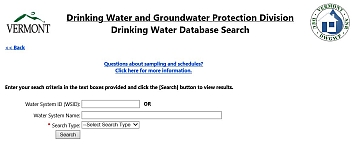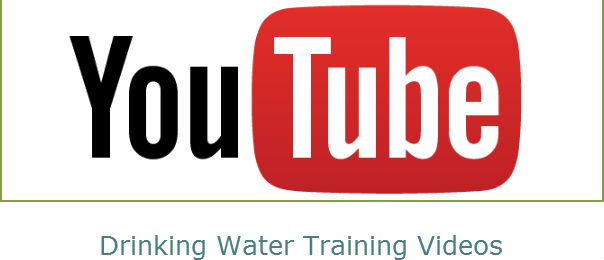Lead and copper are metals that can enter drinking water, primarily from plumbing materials. Community and Non-Transient Non-Community public water systems are regulated under the federal Lead and Copper Rule and the Vermont Water Supply Rule that incorporates the federal rule by reference.
The Lead and Copper Rule (LCR) has many requirements as described on this page, including testing for lead and copper, educating water users, and, if necessary, additional water treatment.
On October 8th 2024, the U.S. Environmental Protection Agency (EPA) released the final Lead and Copper Rule Improvements (LCRI) which will change the lead drinking water sampling process, lower the lead action level to 10 ppb, and set a replacement timeline for all lead service lines. The LCRI compliance date is November 1st, 2027. The Drinking Water and Groundwater Protection Division is in the process of reviewing the LCRI and will update this website with more information as it becomes available.
For more information on service line inventories and replacement plans, visit our Service Line Inventories webpage.
A school or child care facility that has its own well and water treatment is regulated under the LCR as described below if it is a public water system. Vermont also has a state requirement for testing and remediating lead in school and child care drinking water, Act 66 of 2019.
Sources and LCR Regulatory Standards
The federal drinking water standards for lead are a Maximum Contaminant Level Goal (MCLG) of zero and an action level (AL) of 0.015 mg/L = 15 ppb. Copper is a micronutrient but can cause health effects if too high. Copper has an MCLG of 1.3 mg/L and AL of 1.3 mg/L = 1300 ppb). Copper also has a secondary standard due to aesthetic effects such as color, staining, and taste (SMCL of 1.0 mg/L).
The most common sources of lead and copper in drinking water are plumbing materials throughout the water distribution system, especially if they corrode (break down) over time. Lead and copper are elements that have been used in plumbing materials (pipes, valves, solder, fixtures, faucets, etc.) by themselves and in alloys of multiple metals such as brass. Lead is a neurotoxin and causes other health effects.
Environmental regulations have reduced multiple sources of lead in the environment to protect public health, including significant reductions in the amount of lead allowed in plumbing and solder. For more information on sources and health effects of lead, please visit the websites below:
Vermont Lead in Consumer Products Law including plumbing and solder (Vermont Attorney General)
Use of Lead Free Pipes, Fittings, Fixtures, Solder, and Flux for Drinking Water (US EPA)
Protect Your Tap: A Quick Check for Lead (EPA, interactive tool to determine lead sources plus testing info)
Basic Information about Lead in Drinking Water (US EPA)
Lead in Drinking Water (Vermont Department of Health)
LCR Sampling Requirements and Procedures
Public water systems regulated under the LCR must collect lead and copper samples from specific locations, and according to a monitoring schedule with frequencies and number of required samples that vary during the history of the water system. Currently, lead and copper samples are usually collected in the same sample bottle. Additional special diagnostic samples are required in some circumstances.
Vermont Lead and Copper Small System Sampling Guidance
Lead and Copper Sampling Plan
Routine samples must be collected from locations in the distribution system (where lead and copper enter drinking water) according to a Division-approved Lead and Copper Sampling Plan. Sites from the distribution are prioritized for inclusion in the plan based on plumbing materials expected to have the highest risk for lead contamination according to specific criteria in the LCR. Community water systems must sample from residential kitchen or bathroom faucets. NTNC systems must sample from consumptive taps.
Lead and Copper Sampling Plan (online form)
Monitoring Schedules (frequency and number)
The frequency of sampling and the number of samples required per monitoring period are based mainly on the user population size and prior lead and copper results. Some systems are required to sample lead and copper in six-month monitoring periods (usually after a water source or treatment change or after a lead or copper action level exceedance).
DWGWPD Public Water System Monitoring Schedules
Systems on reduced monitoring sample every year or once every three years between June 1 and September 30. Water systems serving connections with varied seasonal use and occupancy that are already on reduced monitoring may apply for approval to sample between February 1 and May 31.
Alternate Lead and Copper Monitoring Schedule Application (online form)
How to Collect Lead and Copper Samples
Lead and copper samples for water system compliance must be "first-draw" samples taken from cold water taps where the water has not been used for at least 6 hours. Taps should be those in regular use for drinking and cooking. Artificial pre-stagnation flushing is prohibited. Screens and aerators should be carefully removed, rinsed, and replaced as part of routine maintenance but they must be left in place prior to compliance sampling. Details on sample collection are provided in the directions below for water systems and for water systems to provide to residents or employees collecting samples for the water system. U.S. EPA published a memo in February 2016 reiterating proper sample collection techniques.
Directions for Water Systems on Lead and Copper Tap Sample Collection
Directions for Lead & Copper Tap Sample Collection by Residents
EPA sample collection guidance (EPA February 2016, distributed as sample collection policy for Vermont, and incorporated in later Rule revisions.)
Lead Consumer Notices
After each round of LCR compliance monitoring, each water system is required to provide participants whose individual locations were sampled with their lead results within 30 days of receiving the lab results, or 3 days if the individual tap result was above the action level of 15ppb. This is required even if the results are all very low. The document below has templates to use that include the required health language. Return a copy of a notice and the certification form to the Division.
Community System Consumer Notice of Lead Tap Water Monitoring Results Template
NTNC Consumer Notice of Lead Tap Water Monitoring Results Template
Consumer Notice of Lead Tap Water Monitoring Results Certification form (online form)
The Division has created follow along videos on how to fill out the consumer notice template and the certification form which can be found on the Drinking Water Groundwater Protection Division's YouTube page.
Community water systems are required to provide basic information about lead in their Consumer Confidence Report (CCR, annual water quality report to all users) such as flushing the cold water tap before getting water for drinking and cooking. The CCR also must include a summary of the most recent round of lead and copper testing at that water system.
If there is a lead action level exceedance, information must be provided promptly to all water system users in case the problem is widespread (see next section).
Action Levels and Action Level Exceedances
Calculation of the 90th Percentile
Instead of maximum contaminant levels (MCLs), lead and copper have action levels (ALs) based on the 90th percentile result. A 90th percentile result is determined by ranking the results and determining where 10% of samples are higher. For a system collecting 10 samples, the 90th percentile result is the 2nd highest result. For a system collecting 5 samples, the 90th percentile result is the average of the two highest results. 90th percentile results are calculated separately for lead and copper, and separately in each monitoring period.
Use the 90th percentile calculator to calculate the 90th percentile value for lead and/or copper results.
Action Level Exceedances
An action level exceedance for either lead or copper occurs when the 90th percentile is above the action level for lead and copper:
Lead Action Level: 0.015 milligrams per liter (mg/L) = 15 parts per billion (ppb)
Copper Action Level: 1.3 mg/L
Following action level exceedances for lead or copper, the water system must collect a standard set of samples for lead and copper every 6 months and is likely to have additional water chemistry monitoring requirements described in the section below. Failure to complete any of these activities before specified deadlines would result in a violation.
Combined Lead Tier 1 Public Notice (PN) and Public Education (PE)
*This requirement has significantly changed since the release of the LCRI. Please read the information below carefully regarding the new requirement*
When there is a lead action level exceedance, the water system must issue a combined lead Tier 1 Public Notice and Public Education within 24 hours of receiving the Lead Action Level Exceedance letter and 90th percentile calculation from the Division. The combined Lead Tier 1 PN and PE distribution instructions vary depending on the system type and population size. The Division will send a customized template and specific distribution instructions to the Water System.
A Combined PN and PE certification form must be filled out and submitted to the Division within 24 hours of issuing the combined notice.
Combined Public Notice/Public Education Certification form (online form)
A copy of the distributed Tier 1 Public Notice and Public Education and certification must be emailed to the EPA (LeadALE@epa.gov). After receiving the copy of the notice and certification, the Division will email the required documentation to the EPA and will include the Water System contacts in the email.
Corrosion Control and Reducing Lead and/or Copper
Lead Reduction Strategies: Flushing
Water Quality Parameter Monitoring
After a lead or copper action level exceedance, the Division will send the water system a letter outlining compliance requirements and deadlines. This will usually include taking additional water quality samples at the entry point to distribution (a check on lead and copper; and for pH, alkalinity, calcium, and others that may affect corrosion).
Corrosion Control Treatment
Based on that chemistry data, the water system must submit a corrosion control treatment (CCT) recommendation.
CCT Recommendation Guidance and Form (developed following the 2016 EPA guidance document) (online form)
Dissolved Inorganic Carbon (DIC) table
Further compliance steps and deadlines including installation of CCT or optimization of existing CCT will depend on subsequent lead and copper results.
If you have questions about Lead and Copper Rule implementation in Vermont, please contact Compliance Section staff.
| Community Water System | NTNC Water Systems |
|---|---|
| Joshua Gravlin joshua.gravlin@vermont.gov 802-261-1360 |
Ana Hebert ana.hebert@vermont.gov 802-261-5603 |


